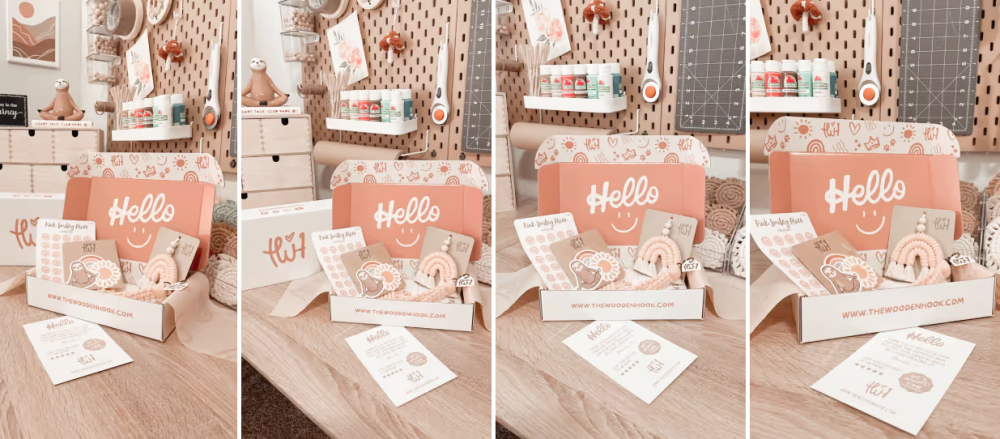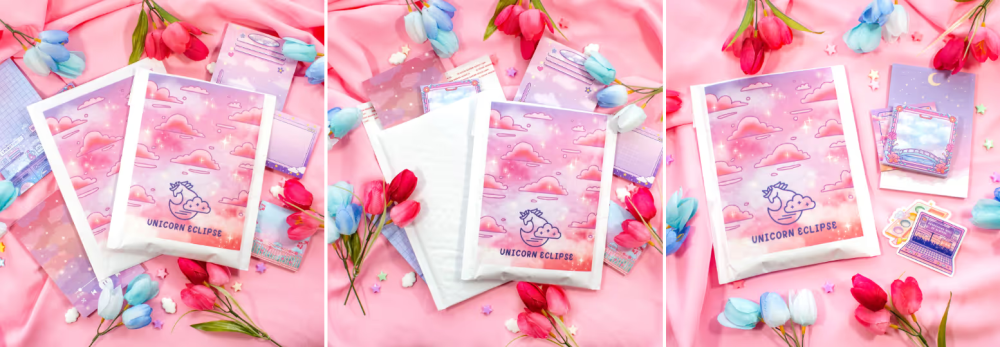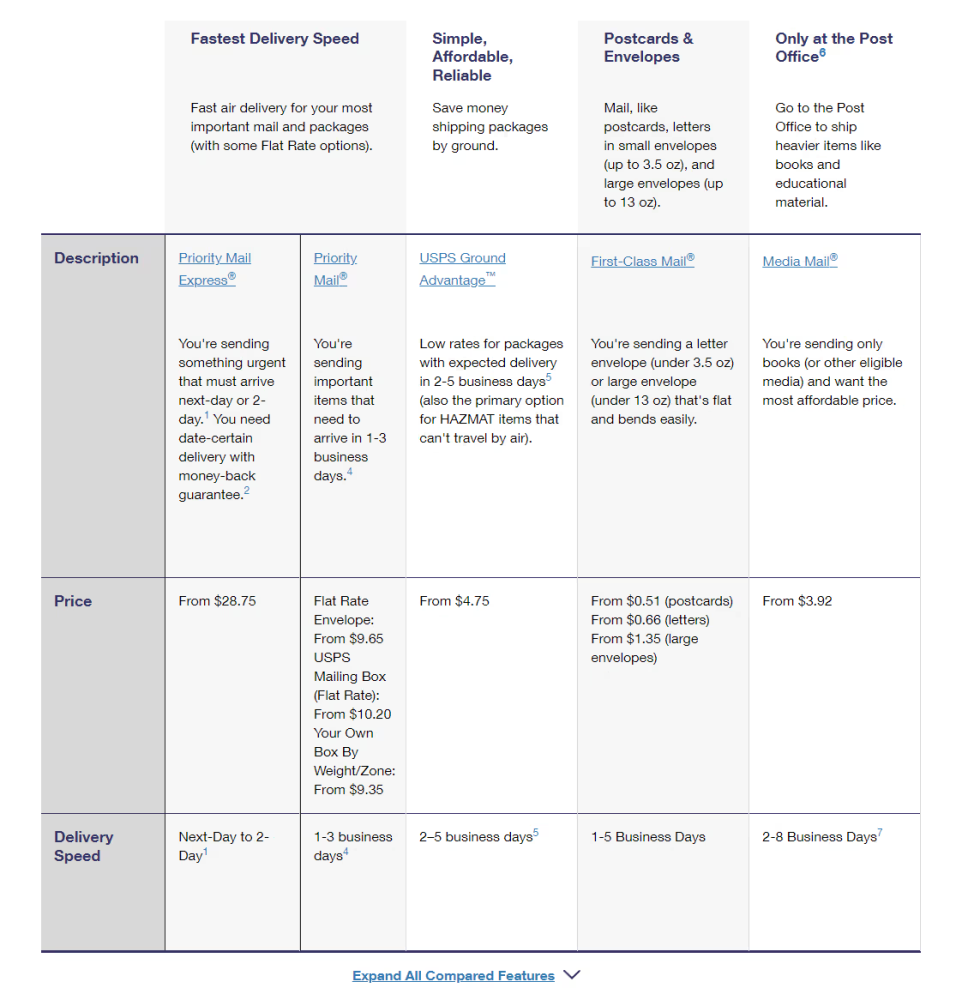Learn about the factors you need to consider when shipping your ecommerce products.
Are you thinking about starting an ecommerce business? Do you want to know how to ship products to customers?
Shipping is all about choosing the right packaging materials and how they could affect shipping costs. This guide will show you all the different types of packaging you could use to fulfill orders. It’ll also explain some of the factors you need to consider before shipping your products.
Let’s start by defining what ecommerce packaging is.
Table of Contents
What Is Ecommerce Packaging?


Ecommerce Mailer Boxes by The Wooden Hook Store
Ecommerce packaging refers to the materials used to ship online orders to customers.
There are no rules as to what type of packaging one should use. Business owners have the freedom to choose which materials they want to use to fulfill orders. However, some options have become more popular than others over the years.
What’s important is that you find packaging materials that make sense for your business. You want packaging that’s able to withstand rough shipping conditions. Having the option to customize these materials is just as crucial.
Many businesses put a lot of effort into their packaging. Some to the point of obsessing over them.
Why is that?
The Importance of Ecommerce Packaging
You could say that ecommerce packaging plays two important roles in the order fulfillment process.
The first one would be product protection. You want products to arrive in the same condition they were in when you packed them. Shipping conditions are often rough and unpredictable. That’s why you want to choose packaging materials that have the highest chance of keeping products in pristine condition.
The second role is branding. You want to use your packaging material to distinguish yourself from competitors. Show customers what your brand is all about. Give them the ultimate unboxing experience to improve your chances of getting repeat orders.
How to Ship Products to Customers
You’ll need to get the right packaging material to ship your products successfully. If your packaging material is flimsy, the risk of products getting damaged during transport increases.
Let’s look at some of the most popular materials used for ecommerce.
Mailer Boxes


Gradient Ecommerce Packaging by PitaChan
Mailer boxes are the best packaging material for businesses. They’re smaller than shipping boxes so they’re great for transporting single purchases. These come in different sizes too so you can find ones that will fit your products just right.
Apparel businesses use these all the time. But they also work for food and cosmetic products as well. Some jewelry retailers pack items like earrings in smaller mailer boxes.
The reason why ecommerce sites use mailer boxes is their look. Their presentation brings the unboxing experience to another level.
Shipping Boxes


Shipping Boxes by Pretty Girl Bangles
Shipping boxes are larger than mailer boxes which makes them ideal for delivering larger products. These are also essential for fulfilling bulk orders.
Not only are shipping boxes bigger but they’re a bit tougher as well. Remember, these are meant to transport heavier items. Your products should stay safe inside. But if you want to protect them further, consider placing your merch inside product boxes.
Because of their size, shipping boxes leave you some room to add information that wouldn’t fit in a smaller box. Print handling instructions, warnings, or shipping information.
Poly Mailers


Aesthetic Stationery Bubble Mailers by Unicorn Eclipse
If you’re looking for more affordable ecommerce packaging, you should look into poly mailers. These are plastic mailing bags that are ideal for shipping items that aren’t fragile. For example, these would be great for those who’d like to send clothing, footwear, or paper goods.
Because they’re lighter than boxes, poly mailers could lower shipping costs. They’re easier to store as well since they don’t take up much space.
They are tear- and water-resistant so your products will stay safe while inside. Poly mailers are self-sealing which helps business owners pack products faster.
Packaging Accessories


Holiday Candle Packaging by Earthside Co
Aside from packaging materials, you should also consider including packaging accessories to improve the unboxing experience.
For instance, you can include a personalized thank you card to put a smile on every customer’s face. If you’re selling clothes, attaching a hang tag would be a nice touch. This will allow you to promote your brand and provide information customers might need to take care of their clothes properly.
Tissue paper is another popular accessory that you might want to get. Wrap these around your products to add another layer of protection. They also make your products look more premium.
Ecommerce Shipping: Factors to Consider
There are several factors that you have to think about when shipping products. You have to consider the fees you have to pay, the variables that affect shipping costs, and your branding.
Understanding all of these will help make the process smoother for everyone concerned. Let’s break down each one.
Shipping Fees
One of the first considerations when delivering products is the shipping fee. Either you or your customers will have to pay for it.
There are three popular setups that ecommerce businesses typically use. Each one has its advantages and disadvantages.
Free Shipping
Free shipping incentivizes customers to push through with their purchases. It lowers cart abandonment rates and gives businesses a competitive edge.
However, this setup means you’re the one who’s going to shoulder the costs. There are ways to make up for it like raising your prices or taking it out of your total sales. Some also require a minimum order amount to qualify for free shipping.
Real-Time Carrier Rates
Another strategy is to charge customers real-time carrier rates. It’s a more accurate way of billing customers for shipping. It takes into account the destination, package weight, and the shipping method selected.
The good thing about this is that it’s a fair way to determine how much customers need to pay for shipping. The downside is that it’s not consistent. And some customers have to pay a larger fee if they live far from your warehouse or if they order more products.
Flat Rate
A flat rate is good because customers can depend on costs being consistent regardless of when they order or how they want their products shipped. In short — it keeps things simple.
This is a good option if you’re selling products that have roughly the same weight and size since the shipping rate would stay consistent. But if the size and weight are different, your shipping fee would be all over the place which will hurt you over time.


Ecommerce Custom Logo Tissue Paper by Knots and Fringe
Shipping Costs
Ecommerce shipping becomes easier to account for if business owners understand what goes into calculating its costs. These include the weight of packages, their size, the point of origin, and their destination.
Shipping couriers have slightly different ways of calculating their shipping fees. So you’ll have to get in touch with your preferred courier to find out if its shipping fee makes sense for your business.
Below is a mail shipping guide from the USPS for reference.


Remember that you have to take into account your margins. Otherwise, you might not be able to sustain your online business.
Branding


Using plain packaging won’t do much for your company branding. Each package you send customers is a chance for you to make your business known. If your packaging design looks excellent, you’ll look more professional in the eyes of your customers.
The simplest way to add branding to your packaging would be to add your company logo. But you can do more than that. Online sellers like inserting text that shows their personality. Some rely on images to show what they’re all about.
If you’re an environmentally conscious brand, you’ll have to be careful about what packaging material you’ll use. Pick a material that’s recyclable to ease your customers’ minds.
You can go with a wacky design or keep it professional. It all depends on what vibe you’re after. That’s why you should know who your audience is and base your design on them.
Ecommerce Packaging Tips
Here are a couple of helpful tips that you should keep in mind when shipping products.
- Buy in Bulk — Though it might cost you more initially, you’ll save money if you buy your packaging materials in bulk.
- Customize the Packaging Size — Find a packaging supplier that’ll let you customize the width, depth, and height of your packaging materials. This could reduce shipping costs and secure products better.
- Track Deliveries — Some couriers offer a tracking feature. If yours does, use it. It’ll give you and your customers peace of mind.
- Order Sample Boxes — Use your sample to determine how well you could pack your products in it. This will also give you a chance to see your design on the packaging. Only order in bulk once you’re happy with the design and box dimensions.
- Get Customer Feedback — Ask customers if they have suggestions or concerns regarding how you handled shipping. Their perspective might reveal inefficiencies in your system.
Recap
The first step to shipping ecommerce products is finding the best packaging to use for your business. Your best bet would be mailer boxes and poly mailers, depending on what type of products you sell.
You can also use shipping boxes if your customers tend to order in bulk or if your products are too big for standard box sizes.
Researching couriers is the next step. Each one has its way of calculating shipping fees, but they all consider your package’s weight, size, and destination. Find a courier whose fees make the most sense to you.
If you wish to learn more about ecommerce packaging, here are other blog posts that we recommend you read:
PackM also has a Design Hub where you can see ecommerce packaging designs made by our customers.







